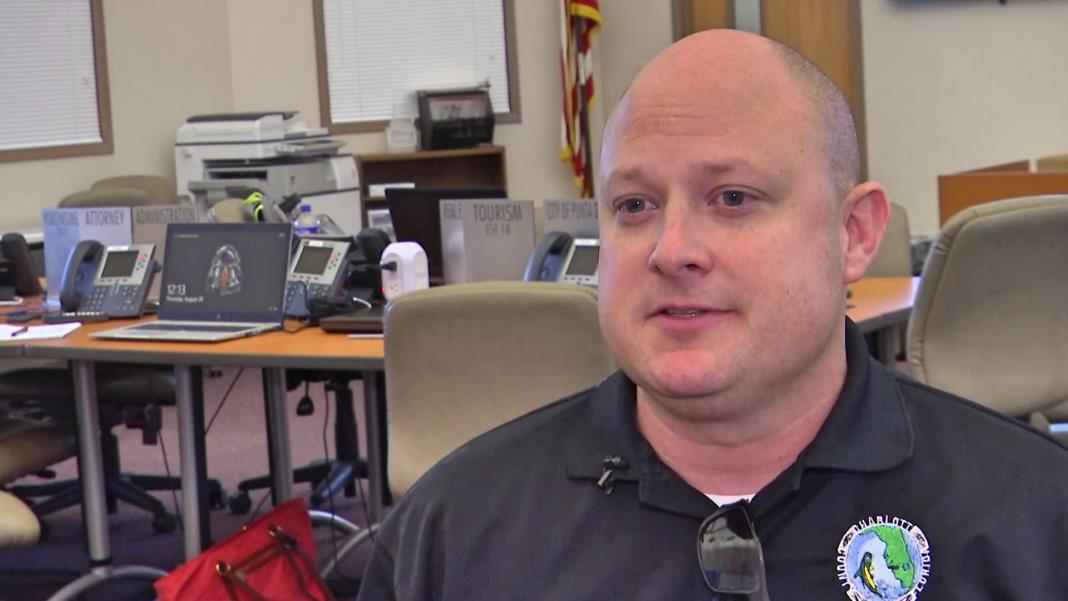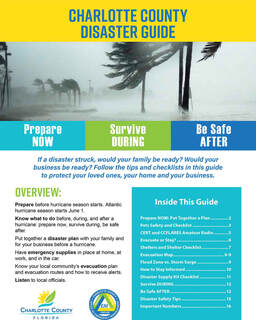06.21.24 Hurricane Preparedness
A small but attentive audience gathered on June 21st to hear the experts speak about hurricane protocols and procedures. PIE President Meryl Schaffer introduced the speakers: Patrick Fuller (Director of Charlotte County Emergency Management) and Jason Fair (Charlotte County Fire Chief).
Patrick Fuller began with the bad news: experts at the National Hurricane Center predict an extremely active year – the highest expected ever. There is no La Nina to inhibit storms and the water temperatures are now as warm as the average for August. The first named storm of the season — Alberto –- caused a storm surge as far north as Louisiana.
Here are some highlights from the presentation:
- DO NOT STAY IN A STORM! We live on a Barrier Island, the last strip of land before the mainland.
- Know your ZONE: we are in the RED ZONE. It is possible for storms to over wash the Island. Mr. Fuller emphasized that no two storms are the same in terms of speed and size and can’t be expected to behave in the same way.
- PREPARE IN ADVANCE>: Have an evacuation plan. FIRST plan to stay with a friend or family member outside the area. YOU DO NOT HAVE TO GO LONG DISTANCES. Get away from the most deadly aspects of the storm, which is storm surge and/or flood waters. STORM SURGE is the #1 killer in a hurricane. 60% of hurricane deaths are water-related.
Charlotte County developed with most of its infrastructure within the lowest evacuation zones. Everything is built near the water. The County does NOT have enough shelter space. There are 3 schools and a recreation center, that is all.
- GET OUT well in ADVANCE of a storm, 4-5 days before landfall. Your evacuation route is any road that gets you away from the impact area. If you wait too long you run the risk of being stuck in traffic and potentially running out of gas.
- What is the evacuation procedure? There isn’t an exact time evacuation is called, but usually within 48 hours of the storm. Emergency management holds a press conference to make the announcement. At that point, EMS will not respond. If evacuation is declared, crews will be moving out for the safety of Charlotte County personnel. There is no set communication announcing their departure. The threshold to stop operating fire and EMS vehicles is gale force winds (45 MPH+). At that point emergency calls pile up at dispatch, all departments stop work.
- SPECIAL NEEDS: Help for people dependent on medical devices (i.e. oxygen) or who have cognitive/memory impairment. File an application with Emergency Management to get access to a special needs shelter located in a church in Port Charlotte. FL Dept of Health reviews the applications and determines qualification for access, but you must be registered in advance. CC Transit picks up qualified people to transport them to the shelter. Again, the first evacuation choice should NOT be a shelter. Shelter information is available on page 7 of brochure.
- SIGN UP for “Alert Charlotte” (alertcharlotte.com, page 4 of guide). Give them your address and a means to communicate: cell, email, landline. Emergency Management will notify you when an evacuation is called. “Alert Charlotte”, the wireless emergency system, replaced the old Emergency Broadcast System and will notify for civil emergencies and weather emergencies. They also provide weather alerts (i.e. thunderstorms) etc. DO NOT TURN THE ALERTS OFF.
- Maintain an emergency supply kit, enough for 5-7 days. Remember that now there are more billion dollar disasters than ever because more people live in disaster-prone areas. There is competition for resources after events, and wider time gaps between events allow these resources time to build up. If there are back-to-back events the longer the wait for resources and assistance to arrive. Next sales tax holiday is last week of August – good for large ticket items like generators.
- KEEP IN CONTACT (stay informed): follow social media before the storm. Digital means usually fail in a storm. Make sure you have a battery powered radio in the event of cell tower failure. There is a volunteer group in CC for amateur ham radio operators (last resort communications) Information hubs and drop centers used by CC are fire houses, libraries, recreation centers. Static locations that have information and resources after the storm (i.e. charging stations)

Jason Fair, Charlotte County Fire Chief

PATRICK FULLER Director of Charlotte County Emergency Management
- Don’t engage in unsafe activities. SAFETY after a storm is most important. There are more fatalities after a storm due to dangerous conditions than by the direct impact of the storms. ALL FLOOD WATER is contaminated (open wounds in water get infected, can cause fatal sepsis). Know how to operate a generator correctly and keep it 20 feet from the house. Use a CO2 monitor.
- AFTER A STORM the best info comes from Station 10. Island is considered a “Neighborhood Pod” for relief and assistance (i.e. military drops after Ian, MREs). Emergency Management can work with the fire dept on-scene for communication.
- Who looks at results and makes future changes to building code, regs? Florida Association of Building Officials review after each storm and make recommendations. FEMA also has Mitigation Assessment Teams. Reporting is available online.
In the past the focus was on industrial buildings. Wind-driven rain issues have to do with the duration of the storms. Code was not designed to take wind-driven raid for periods of 12+ hours. Current code may not stand up to low-moving and powerful storms. However, building to ICC 500, the international building code, would be prohibitive.
- Is there any relief available for homes that are still damaged? Debris can be dangerous going into storm season. Having condemned homes removed works like derelict vessels, which is a very long process. If there is a safety or health concern go to code enforcement. There is a “Rebuild Florida” program sponsored by FloridaCommerce that provides state administered grants to assist in outstanding repairs. Eligibility requirements at Rebuild Florida Hurricane Ian Housing Recovery Efforts.
- DON’T MISINTERPRET THE “CONE”: new visual graphic. Cone has gotten smaller to reflect only the center of the storm. They removed the center line from the cone, so people will understand that the center of storm is likely to be somewhere within the cone. FOLLOW THE OFFICIAL GOVERNMENT SOURCES: National Hurricane Center, the National Weather Service (Tampa area, Ruskin)
The trigger for evacuations is “slosh model” based on potential inundation, usually when prediction puts storm surge potential at 4’ above ground level.
Both speakers emphasized: you don’t have to evacuate from the path of the storm, just evacuate AWAY FROM WATER. Todd Dunn added ways that the County disseminates information: on FB, NextDoor, Alert Charlotte, Media (TV, radio) and local public radio stations like WGCU.
- Are the Station 10 vehicles taken off the Island? Evacuation of the citizens is their first priority. They make an effort to get fire equipment off the Island and protected but can’t guarantee it will happen. If they have the opportunity, the apparatus comes off Island but the tanker stays. The lessons learned from Ian were about road access, risk assumption
Mr. Fair pointed out that in an evacuation we should NOT assume “oh, they’ll take care of me”. “No, we’re [the fire & EMS personnel] are getting out too.”
- Is there a way to notify evacuated Islanders that fire/EMS was back on Island and station 10 is restored to service? Todd Dunn explained that there is no such thing as an “all clear” after a storm. He explained that communicating this to residents is a double-edged sword. They do not want to create a false sense of security causing people to return if it is still unsafe.
- Mr. Fair emphasized DO NOT CONFUSE ACCESS after a storm for BEING SAFE on the Island. There are structural fires that start when the power comes up. It is easy to make a mistake jumping into restoration, and the hospitals may be closed or damaged during/after the storm. After the last storm the hospital in Punta Gorda had 1st floor water incursion, Fawcett Memorial had vent failures and wind-driven rain. Shorepoint hospital had the least damage. The County has triage-style locations to provide care when the hospitals are closed. CCFD conducted 80 rescues after Ian.

